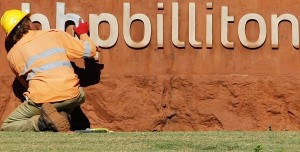I would venture to say that many readers were unaware that the largest primary silver mine by annual production on the planet is in the hands of Australian iron ore and coal juggernaut, BHP Billiton.
That mine is known as Cannington and produced over 31 million ounces of silver in 2013. More than any other mine in the world. It is the tenth largest silver deposit in the world by known reserves with over 215 million ounces of underground silver. Some analysts value the asset at nearly $5 billion.
Cannington is BHP's fifth most productive asset in its copper division and generated revenues of US$1.08 billion in 2013 from a net operating base of only US$234 million.
It is located in north-west Queensland and produces vast amounts of lead and zinc on top of the silver output.
The massive silver mine produces approximately 6% and 7% of the world's silver and lead production, respectively.
The Early Days
The deposit was discovered in 1990 by BHP Minerals and was commissioned in 1997 for $450 million. Full production began in 1999 and has since been expanded to over 3Mtpa.
The sulphide ore extracted from the underground mine is sent to the nearby beneficiation processing facility where silver, lead and zinc concentrates are extracted. The mine produced 213,400t of lead and 56,300t of zinc in the year ended June 2013. The mining life of Cannington is estimated to be 11 years although that is likely to expand.
This asset has been the centre of endless investment banker's pitch books for decades. Cannington doesn't get adequate value and furthermore, it most likely doesn't belong in a gigantic base metals conglomerate like BHP Billiton. As a result, it has been the ideal fit for a carve-out and a fat investment banking fee. To date no bankers have been successful in completing that transaction.
The problem is, it generates significant free cash flow and BHP has yet to feel the need to sell for what it may consider 'less than fair value'.
BHP is the worst type of seller; one that isn't motivate and doesn't need the money.
Billiton Divestment:
With the latest discussions of a massive +$12 billion de-merger of some of BHP Billiton's assets, Cannington has finally been brought to the forefront of these discussions.

BHP Billiton producers more steel-making coal than any other company in the world (Image: BHP Billiton)
BHP has already sold $6.5 billion worth of assets over the last 30 months. The assets currently on the chopping block are essentially the old Billiton assets which were acquired in 2001 for $11.6 billion. These may include nickel, aluminum and manganese.
According to the company the assets set to remain with BHP Billiton after the spinoff accounted for 96% of the company’s EBIT last year.
Coal is also rumored to be part of the divestiture although that is less clear. BHP has previously stated the four pillars of its future are coal, copper, iron ore and oil (and a potential fifth being potash).
In 2001, nickel was less than $5 per pound (today over $8.50 per pound), aluminum was roughly $0.60 per pound (today $0.91 per pound) and manganese traded at roughly $0.50 per kilo and today trades at $2.20.
It will be interesting to see where the final destination for Cannington is, whether it's BHP Billiton, the SpinCo or if its sold to a 3rd party. The latter is likely to generate the most value and should be considered the preferred option. Bankers must be frothing.
BHP Billiton is currently the largest producer of metallurgical (or steel-making) coal in the world and one of the largest iron ore producers.
Due to the tremendous coverage of the possible de-merger, BHP's website actually crashed for a short time on the announcement.
Read: BHP Billiton to Spin Off Units, Reversing Consolidation Trend (NY Times Dealbook)
Also: BHP Eyes Split From Billiton Assets in Mine Spinoff Plan (Bloomberg)






















